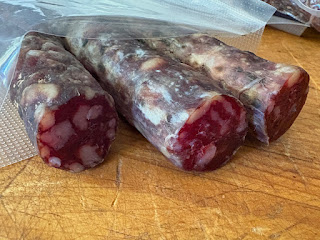Curing or dry aging meat at home is a lot simpler than you might think. It’s all about keeping an environment within a certain temperature and humidity range. Unless you don’t naturally have the ideal environment where you live, like a cave in the Alps of Italy with a constant 16C temp and 70% humidity. But you can build a chamber to create it. Most people in Australia’s southern states will make salami successfully in their garage or under the house in winter, for example. But if you have a charcuterie fridge, you can make stuff all year round.
Temperature
The temperature range should be high enough for the meat to cure properly and dry, but low enough so that bad bacteria and mould don’t grow. This is between 10C and 16C.
Humidity
The humidity should be high enough to stop the outside of the product drying too quickly on the outside, forming a barrier and causing the inside to spoil (case hardening), but not too high as to encourage excessive mould growth. This is between 65% and 75%. Mould growth is good for flavour though, so white or even greenish mould is good. If it’s black, not so much.
Air flow
There should be a little airflow to stop excessive mould growth, but not so much that you cause the product to dry too quickly on the outside, forming a barrier and causing the inside to spoil (case hardening).
The curing process can take anywhere from 2 to 12 weeks, with the thickness of the sausage and the salami type may mature faster than others.
I use a wine refrigerator as a charcuterie cabinet that gives me the almost perfect environment for my salami, see pictures below.







No comments:
Post a Comment